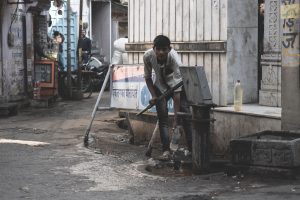Everywhere we see advisories urging handwashing with soap for at least 20 seconds to mitigate the spread of the coronavirus. In India, the pandemic has disproportionately hurt the urban population. It is clear that public health centers may be ill-equipped and understaffed to provide quality and affordable healthcare in this emergency situation. Equally distressing, a significant proportion of urban citizens, especially the urban poor, have no access to adequate water and basic handwashing remains out of their reach, further increasing the risk of COVID-19 spreading further. Due to a narrow focus on domestic water provisions, the wider challenges around accessing water for survival and livelihood are being underemphasized; nevertheless, these are assuming increasing importance because of the rapid spread of COVID-19.
2011 census data reveals that, contrary to the government of India’s service benchmark of 100 percent water coverage, only 70 percent of households have access to tap water, out of which 62 percent have access to treated tap water. In the slums, the corresponding figure is 74 percent, but slum dwellers access water not through individual connections but by community stand posts. To make matters worse, not all households enjoying access to public water supply have access to it within the their homes. Nearly two-thirds of households do not have access to water within their homes, and 8 percent of households need to fetch water from more than 100 meters away from their households.
The burden of collecting, storing, and managing water usually falls on women and girls in most families. In their daily struggle to secure basic water for their households, effectuating hand-washing advice is a distant possibility. Moreover, the duration of the water supply in Indian cities is only 2 to 3 hours on average. As compared to the service benchmark of 135 liters per capita per day (lpcd), cities receive only 69 lpcd on average.
Even intra-city inequity is quite stark as a study on Mumbai estimated that 46 percent of the city use 95 percent of the water while 54 percent of the city, officially living in slums, uses only about 5 percent of the supplied water. According to the recent NITI Aayog report, in the absence of serious policy action, water demand in the country will exceed supply by 2030 and 21 cities including Chennai, Delhi, and Bengaluru could run out of water in 2020. Given such water deficit and the short duration of water availability, especially in the slums, people rush to access the source, making social distancing practically impossible.
Urban households, in general, cope with the water shortages through a slew of measures including self-provisioning (using tube wells or hand pumps), accessing water to private tankers – each of which entails significant investment on the part of households. Urban poor often cede their access to water to the wealthy residents who can pay the premiums for water. In Dharavi, slum dwellers pay 25 rupees ($0.33) for a gallon of water and frequent washing of hands is a luxury that they could ill afford.
Supply is one issue, quality is another. The water supply in almost all cities is often of questionable quality. Water is contaminated through multiple routes, e.g., due to leakages in the public water supply or due to unhygienic treatment and storage facilities of privately available water. A large number of households are also directly dependent on groundwater that is contaminated by improper disposal of domestic sewage, leakages in the sewer network and industrial effluents. Thus, the quality of the water used in the cities can also lead to serious health problems, which may reduce citizens’ immunity and make whole communities susceptible to further disease.
Overall, universal access to water still remains an issue in urban India as the advantage of the mere availability of water infrastructure is subdued either by a lack of access to the public piped water supply or by water supply being both irregular and insufficient. The urban poor are disproportionately affected as they are more likely to need to fetch water from outside their houses and depend on shared facilities. Under the present urban water supply system, inadequate investment with narrow focus on creation of infrastructure, complex institutional set up involving multiple agencies for water supply, fragmentation of roles and responsibilities, limited accountability, inefficiencies owing to leakages, and the bad management of distribution system, weak cost recovery, and limited capacity has led to poor water services to citizens across the cities.
Drastic and unplanned urbanization coupled with displacement of wetlands and lakes further limits cities ability to deal with water shortages. COVID-19 has clearly demonstrated that safe water is crucial to saving lives and so governments and agencies should ensure provision of water to all, targeting the poorest and vulnerable. As urgent measures, city governments should be entrusted with the responsibility of providing door to door water facilities for citizens lacking adequate or no access. In the longer term, government should facilitate better management of water supply through institutional reforms focussing on decentralization of responsibilities to city governments, tariff rationalisation, human resource development, and community participation.
Soumyadip Chattopadhyay is an associate professor at the Department of Economics and Politics at Visva Bharati University Santiniketan.

































